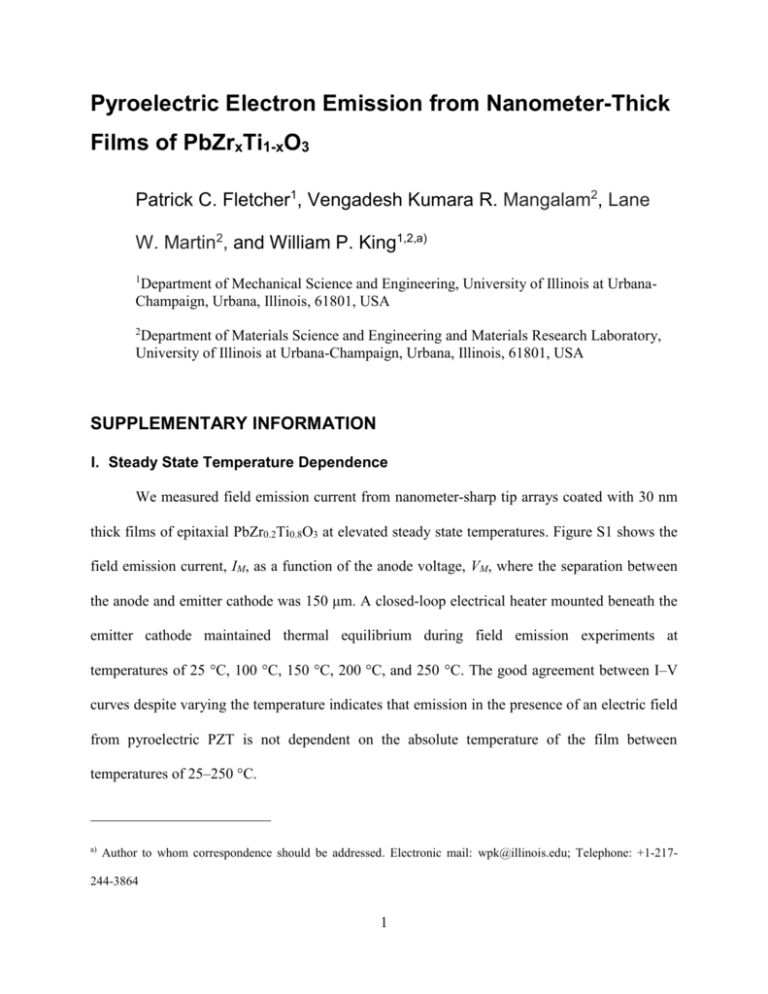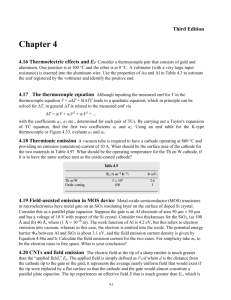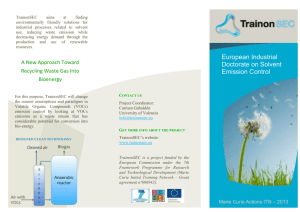Fletcher - Pyro Emission - Supplementary Material
advertisement

Pyroelectric Electron Emission from Nanometer-Thick Films of PbZrxTi1-xO3 Patrick C. Fletcher1, Vengadesh Kumara R. Mangalam2, Lane W. Martin2, and William P. King1,2,a) 1 Department of Mechanical Science and Engineering, University of Illinois at UrbanaChampaign, Urbana, Illinois, 61801, USA 2 Department of Materials Science and Engineering and Materials Research Laboratory, University of Illinois at Urbana-Champaign, Urbana, Illinois, 61801, USA SUPPLEMENTARY INFORMATION I. Steady State Temperature Dependence We measured field emission current from nanometer-sharp tip arrays coated with 30 nm thick films of epitaxial PbZr0.2Ti0.8O3 at elevated steady state temperatures. Figure S1 shows the field emission current, IM, as a function of the anode voltage, VM, where the separation between the anode and emitter cathode was 150 μm. A closed-loop electrical heater mounted beneath the emitter cathode maintained thermal equilibrium during field emission experiments at temperatures of 25 °C, 100 °C, 150 °C, 200 °C, and 250 °C. The good agreement between I–V curves despite varying the temperature indicates that emission in the presence of an electric field from pyroelectric PZT is not dependent on the absolute temperature of the film between temperatures of 25–250 °C. a) Author to whom correspondence should be addressed. Electronic mail: wpk@illinois.edu; Telephone: +1-217- 244-3864 1 FIG. S1. Measured field emission current from tip emitters coated with a 30 nm PbZr0.2Ti0.8O3 film. The emitter chip temperature was constant during field emission testing. II. Field Enhancement Factor We experimentally determined the field enhancement factor for the nanometer-sharp tip arrays coated with 30 nm thick PbZrxTi1-xO3 (PZT) by analyzing Fowler-Nordheim (F-N) type plots of field emission current. The elementary F-N equation for large-area field emitters (LAFEs) is I M aAM 1 2VM 2 d M 2 exp b 3 / 2 d M / VM (1) where IM is the field emission current, a = 1.541×10-6 A eV V-2 and b = 6.831×109 eV-3/2 V m-1 are universal F-N constants, AM = 23.76 mm2 is the macroscopic emission area, ϕ is the emitter work function, γ is the field enhancement factor, VM is the anode voltage, and dM = 150 μm is the anode-cathode separation distance.1-3 This equation is commonly used to make comparisons between LAFEs. 2 Figure S2 shows F-N plots of the field emission data, measured at room temperature, from PbZr0.2Ti0.8O3 and PbZr0.8Ti0.2O3 emitters. The linear relationship between ln(IM/VM2) and 1000/VM for data at low electric field strengths confirms that electron emission is via field emission. The slope (FNSL) and intercept (FNINT) of the F-N linear fits are given in Table S1 and are used to calculate the field enhancement factor. Using Eq. (1), the geometric field enhancement factor for all the PZT emitters is (b 3 / 2 d M ) /( FNSL 103 ) (2) where the FNSL is in units reported by Table S1. We calculated the work function of the PZT films using Eq. (1) and emission data from a control sample of uncoated silicon emitter tips. Details on this calculation can be found elsewhere.4 Since all the tip emitters have about the same height and tip sharpness, we made the assumption that all the emitters have an identical field enhancement factor. The field enhancement factor, γ, is calculated to be about 1526 from the experimental field emission data. This is a large improvement over a flat surface of the same material without tips, and is about 50 times larger than the theoretically calculated γ of 30.1. We attribute this large field enhancement to the uniform tip morphology, uniform emitter spacing, and 10–30 nm radius of the nanometer-sharp tips. Table S1. Experimental field enhancement factor from Fowler-Nordheim analysis. a Tip material FNSL (ln(A/V2)·V/1000) FNINT (ln(A/V2)) Field enhancement factora , γ PZT (20:80) PZT (80:20) -0.67 -9.5 -27.72 -25.02 1526.0 1526.0 γ = (-6.83089×109 V eV-3/2 m-1 × ϕ3/2 × dM) / (FNSL×103) 3 FIG. S2. Fowler-Nordheim (F-N) type plots of measured emission data taken at room temperature. The F-N linear behavior at low electric field strengths confirms field emission. Slopes of the linear fits are given in Table S1 and are used to calculate the field enhancement factor, γ. REFERENCES 1 R. H. Fowler and L. Nordheim, P. R. Soc. Lond. A-Conta. 119, 173 (1928). 2 E. L. Murphy and R. H. Good, Jr., Phys. Rev. 102, 1464 (1956). 3 K. L. Jensen, Advances in Imaging and Electron Physics, (Elsevier, 2007), pp. 1-46. 4 P. C. Fletcher, V. K. R. Mangalam, L. W. Martin, and W. P. King, J. Vac. Sci. Technol. B 31, 021805 (2013). 4








